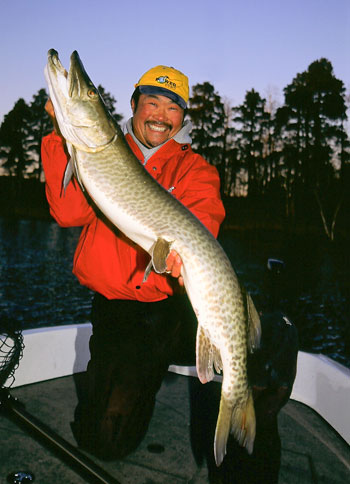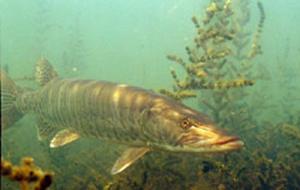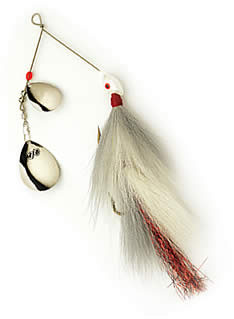It’s not enough to know that giant, hungry muskies haunt weeds in fall. We all know they’re in the green stuff somewhere. Living weeds give off oxygen, cover and shade, and provide muskies with ambush points to snare baitfish hiding among the plants.
 But, anyone who fishes places like Mille Lacs, Lake of the Woods, or Cass Lake knows weed beds can be gigantic. They literally cover miles and miles.
But, anyone who fishes places like Mille Lacs, Lake of the Woods, or Cass Lake knows weed beds can be gigantic. They literally cover miles and miles.
The critical question: which weeds are best? We need to know how to dissect the huge aquatic gardens, cut them down to manageable size, and pinpoint the places that are home to muskies. Knowing how to focus efforts on the most productive areas and narrow our search quickly is even more important during these days of expensive gasoline and precious few free hours to fish due to pressures at work and at home.
We’re busy people. We must be as efficient as we can.
Taking time to study a lake map to single out likely fish-holding vegetation can cut the learning curve. Once on the water, a visual inspection helps spot key features that indicate a particular weed bed is worth a closer look. The process is simple once armed with a few guidelines.
Start by identifying the weed beds on structures that provide both shallow areas and access to deeper water nearby. Locations like those let muskies move quickly from places they feel secure to shallow feeding areas and back again without burning too much of the energy they desperately need to fatten for the winter to come. Look for points and humps that aren’t totally isolated (away from other features). But, they also shouldn’t be overwhelmed by too many structures close by that give muskies too many choices on where to be. There can be too much of a good thing.
The best weed beds are the ones with ‘character,’ meaning lots of features. Flat, shapeless patches with one variety of plant are unlikely to hold many muskies.
 Look for something different. Uneven weed lines, such as turns on the outside and inside edges and changes in depth on the top, increase the odds. They provide muskies with places to conceal themselves along the pathways that baitfish travel. Is there a long straight stretch of weed line that leads to a solitary point? Fish it. Is there a place where weeds rise above the surface from a weed bed of shorter plants, or a depression where the tops of weeds don’t reach as high as the surrounding ones? Fish those, too.
Look for something different. Uneven weed lines, such as turns on the outside and inside edges and changes in depth on the top, increase the odds. They provide muskies with places to conceal themselves along the pathways that baitfish travel. Is there a long straight stretch of weed line that leads to a solitary point? Fish it. Is there a place where weeds rise above the surface from a weed bed of shorter plants, or a depression where the tops of weeds don’t reach as high as the surrounding ones? Fish those, too.
Muskies also position themselves along the edges of pockets deep inside the vegetation. Look for places with two or more kinds of vegetation. More plant species in an area can signal a diversity of bottom content, which means it could be home to a range of aquatic critters, which means there could be a variety of potential muskie food swimming around in the area. Places like that provide a smorgasbord. For that reason, pay particular attention to transition areas where one type of weed meets another.
Add rocks or boulders to the scene and you’ll want to be certain to give the spot a closer look. Check the lake map. The rock piles with “Xs” are shallow enough to be navigation hazards. Target the ones featuring weeds, for sure. There have been autumn days when concentrating solely on those places put several fish in the net and produced several more heart-thumping follows.
Wind is another plus. A breeze ignites the food chain by drifting microscopic plankton to the area, which, in turn, attracts baitfish. But too much wind can make a weed bed a tangled mess that predators will avoid, and strong winds can make boat control an issue. In that case, toss a drift sock overboard to slow boat speed, and use the electric trolling motor to steer.
When you do see or boat a muskie, take note of the kind of weeds that are present. Sometimes they’ll favor coontail, sometimes cabbage, sometimes bulrushes or something else. Are the plants fresh and green or are they starting to turn brown? Details like that help piece together a pattern for the day.
Before moving on, study the lake map, find similar spots, and try them.
Good electronics narrow the search even more. A GPS with a mapping chip that shows the outline of structure and the relative depth of surrounding water are tremendous aids. Use polarized sunglasses and motor along the weed edges, both inside and out. Watch their shape appear on the GPS screen. Pinpoint the twists and turns and visualize where hungry muskies might wait in ambush.
Side imaging sonar, exclusive to Humminbird, can identify other features that don’t appear on the maps, like downed trees, isolated boulders, or rock piles concealed among the vegetation. They create the spot-on-the-spot you want.
View the outline of the edges relative to the shape of the structure. Where do the drop offs and weed lines intersect? They could be critical contact points.
 Good Weed Lures
Good Weed Lures
Choosing a bait to target weeds is simple. Bucktails, with their treble hooks, may snag too often. But spinnerbaits like the M/G Muskie Tandem by Lindy are virtually snag-proof. If they temporarily snag, a quick snap can pop them free–which can also trigger a strike.
Spinnerbaits can be buzzed over the top of weeds, then stopped at the right moment to flutter down through a gap in the canopy where the sun reaches the darkness below. Bet on the fact that weed muskies keep their eyes on that shaft of light for signs of activity.
Cast along weed edges, paying strict attention to the twists and turns in the edges where a muskie might lurk.
Depth and speed are primary triggers, so vary both. Start fast and slow down if you must. The key is to cover as much water as fast as possible.
Large plastics can be rigged weedless and pitched into holes in the cover or used as a throw-back bait at followers. Try a Jackpot or other surface bait over pockets and along the edges.
A follow from a tentative muskie is an invitation to change some part of your tactic. Switch baits or simply use the rod tip to quickly change the direction of the same lure you’re using. Always figure 8 at boatside. If the muskie still won’t grab the lure, mark the spot on the GPS and leave for a while. Play the odds, and return when odds are in your favor. Try later in the day, or when the wind changes speed or direction, or when a storm approaches.
If a muskie finally does explode on your bait, you’ll know you’re learning the most important lesson there is in any kind of fishing–the ability to analyze a body of water to find the 10 percent that holds most of the fish.
After all, everyone knows the fish are in there somewhere.










